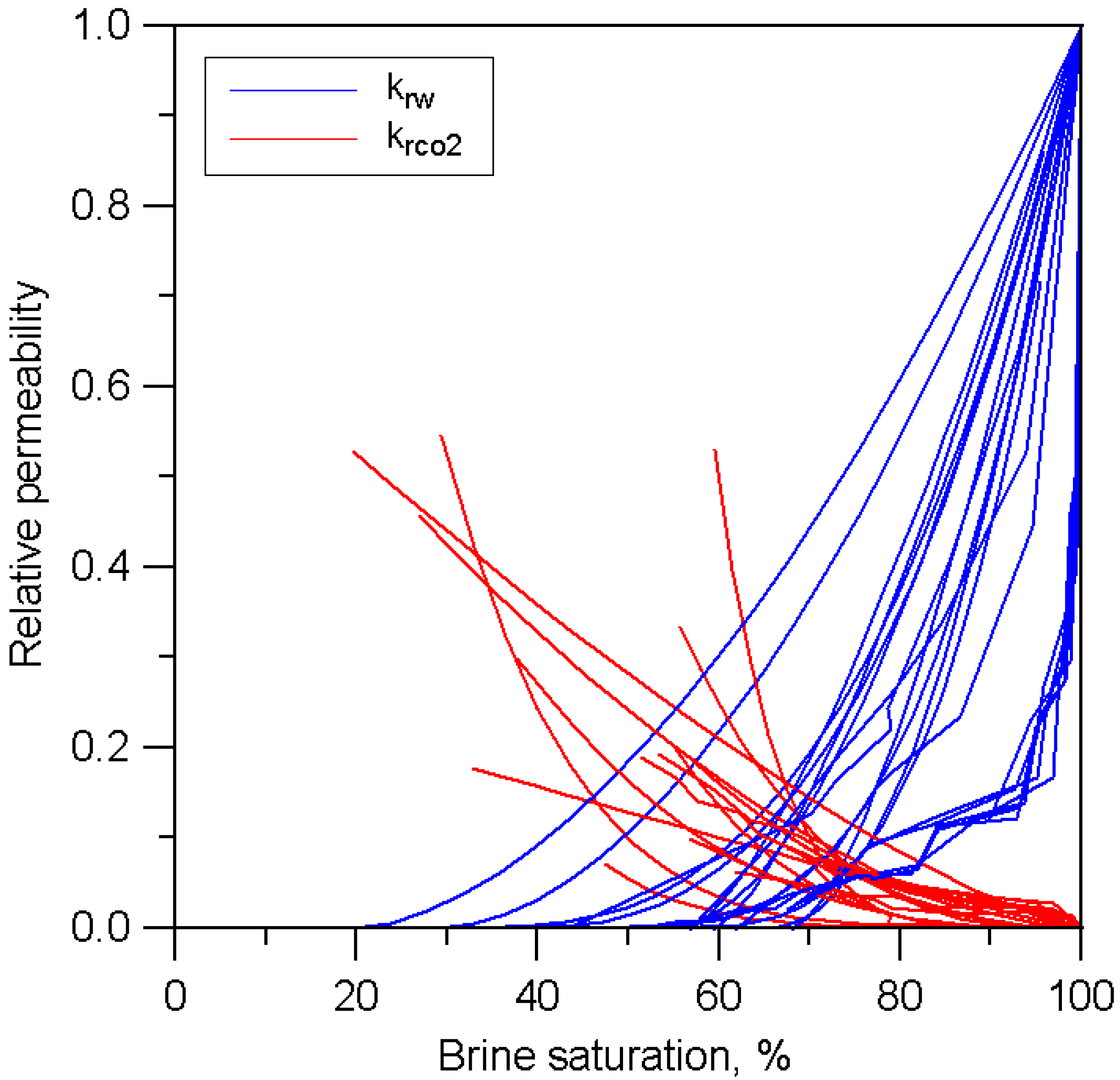Effect of the Flow Rate on the Relative Permeability Curve in the CO2 and Brine System for CO2 Sequestration
Abstract
1. Introduction
2. Experiment
2.1. Experimental Apparatus
2.2. Experimental Condition
2.3. Experimental Procedure
3. Results and Discussion
4. Conclusions
- The CO2 endpoint relative permeability measured at all flow rates was less than 0.5, and the residual brine saturation rate was higher than 40%. These experimental results are consistent with the previous studies and are in sharp contrast to the oil/water system. They also show the dependence of CO2 injection rate: the measured endpoint relative permeability of CO2 increases with the measured irreducible brine saturation decreasing as flow rate increases.
- Although increasing flow rate causes the viscous force to increase linearly, capillary pressure increases sharply. From the experiments, we observed that the changes in the residual brine saturation and CO2 endpoint relative permeability are small in high flow rate conditions compared to the case of low flow rate conditions. This causes the CO2 endpoint relative permeability to converge to a specific value that limits the displacing process.
- To estimate the storage capacity and flow efficiency of CO2 in reservoir simulation techniques, the changes in endpoint values along flow rate conditions should be considered. Letting the flow rate increase can cause a high injectable CO2 amount with low residual brine saturation. For this reason, the capacity of the injection pump and relevant facilities should be optimized based on the dependency of the relative permeability on the CO2 injection rate.
Author Contributions
Funding
Institutional Review Board Statement
Informed Consent Statement
Data Availability Statement
Conflicts of Interest
References
- IPCC (Intergovernmental Panel on Climate Change). IPCC Special Report on Carbon Dioxide Capture and Storage; Cambridge University Press: New York, NY, USA, 2005. [Google Scholar]
- Bachu, S. Screening and ranking of sedimentary basins for sequestration of CO2 in geological media in response to climate change. Environ. Geol. 2003, 44, 277–289. [Google Scholar] [CrossRef]
- Apps, J.A.; Zheng, L.; Zhang, Y.; Xu, T. Evaluation of potential changes in groundwater quality in response to CO2 leakage from deep geologic storage. Transp. Porous Media 2010, 82, 215–246. [Google Scholar] [CrossRef]
- Würdemann, H.; Möller, F.; Kühn, M.; Heidug, W.; Christensen, N.P.; Borm, G.; Schilling, F.R. CO2SINK—From site characterisation and risk assessment to monitoring and verification: One year of operational experience with the field laboratory for CO2 storage at Ketzin, Germany. Int. J. Greenh. Gas Control 2010, 4, 938–951. [Google Scholar] [CrossRef]
- Martens, S.; Liebscher, A.; Möller, F.; Würdemann, H.; Schilling, F.; Kühn, M. Progress report on the first European on-shore CO2 storage site at Ketzin (Germany)—Second year of injection. Energy Procedia 2011, 4, 3246–3253. [Google Scholar] [CrossRef]
- Honarpour, M.M.; Koederitz, L.; Harvey, A.H. Relative Permeability of Petroleum Reservoirs; CRC Press Ltd.: Boca Raton, FL, USA, 1986. [Google Scholar]
- Benson, S.; Pini, R.; Reynolds, C.; Krevor, S. Relative Permeability Analysis to Describe Multi-Phase Flow in CO2 Storage Reservoirs; No. 2; Global CCS Institute: Melbourne, Australia, 2013. [Google Scholar]
- Fulcher, R.A.; Ertekin, T.; Stahl, C.D. Effect of capillary number and its constituents on two phase relative permeability curves. J. Pet. Technol. 1985, 37, 249–260. [Google Scholar] [CrossRef]
- Krevor, S.C.M.; Pini, R.; Zuo, L.; Benson, S.M. Relative permeability and trapping of CO2 and water in sandstone rocks at reservoir conditions. Water Resour. Res. 2012. [Google Scholar] [CrossRef]
- Perrin, J.C.; Krause, M.; Kuo, C.W.; Milijkovic, L.; Chabora, E.; Benson, S.M. Core-scale experimental study of relative permeability properties of CO2 and brine in reservoir rocks. Energy Procedia 2009, 1, 3515–3522. [Google Scholar] [CrossRef]
- Bennion, B.; Bachu, S. Drainage and imbibition relative permeability relationships for supercritical CO2/brine and H2S/brine systems in intergranular sandstone carbonate shale and anhydrite rocks. SPE Reserv. Eval. Eng. 2008, 11, 487–496. [Google Scholar] [CrossRef]
- Bachu, S. Drainage and imbibition CO2/brine relative permeability curves at in situ conditions for sandstone formations in western Canada. Energy Procedia 2013, 37, 4428–4436. [Google Scholar] [CrossRef]
- Shi, J.Q.; Xue, Z.; Durucan, S. Supercritical CO2 core flooding and imbibition in Berea sandstone—CT imaging and numerical simulation. Energy Procedia 2011, 4, 5001–5008. [Google Scholar] [CrossRef]
- Richardson, J.G.; Kerver, J.K.; Hafford, J.A.; Osoba, J.S. Laboratory determination of relative permeability. J. Pet. Technol. 1952, 4, 3375–3385. [Google Scholar] [CrossRef]
- Johnson, E.F.; Bossler, D.P.; Naumann, V.O. Calculation of relative permeability from displacement experiments. Trans. AIME 1959, 216, 370–372. [Google Scholar] [CrossRef]
- Jones, S.C.; Roszelle, W.O. Graphical techniques for determining relative permeability from displacement experiments. J. Pet. Technol. 1978, 30, 807–817. [Google Scholar] [CrossRef]
- Levine, J.S.; Goldberg, D.S.; Lackner, K.S.; Matter, J.M.; Supp, M.G.; Ramakrishnan, T.S. Relative permeability experiments of carbon dioxide displacing brine and their implications for carbon sequestration. Environ. Sci. Technol. 2014, 48, 811–818. [Google Scholar] [CrossRef] [PubMed]
- Müller, N. Supercritical CO2-brine relative permeability experiments in Reservoir Rocks—Literature Review and Recommendations. Transp. Porous Media 2011, 87, 367–383. [Google Scholar] [CrossRef]
- Perrin, J.C.; Benson, S. An experimental study on the influence of sub-core scale heterogeneities on CO2 distribution in reservoir rocks. Transp. Porous Media 2010, 82, 93–109. [Google Scholar] [CrossRef]
- Pini, R.; Benson, M. Simultaneous determination of capillary pressure and relative permeability curves from core-flooding experiments with various fluid pairs. Water Resour. Res. 2013, 49, 3516–3530. [Google Scholar] [CrossRef]
- Jeong, G.S.; Lee, J.; Ki, S.; Huh, D.; Park, C. Effects of viscosity ratio, interfacial tension and flow rate on hysteric relative permeability of CO2/brine systems. Energy 2017, 133, 62–69. [Google Scholar] [CrossRef]
- Soriush, M.; Wessel-Berg, D.; Torasaeter, O.; Kleppe, J. Investigating impact of flow rate and wettability on residual trapping in CO2 storage in saline aquifers through relative permeability experiments. Energy Environ. Res. 2013, 3, 53–72. [Google Scholar] [CrossRef]
- Osoba, J.S.; Richardson, J.G.; Kerver, J.K.; Hafford, J.A.; Blair, P.M. Laboratory measurements of relative permeability. J. Pet. Technol. 1951, 3, 47–55. [Google Scholar] [CrossRef]
- Richardson, J.G. The calculation of waterflood recovery from steady-state relative permeability data. J. Pet. Technol. 1957, 9, 64–66. [Google Scholar] [CrossRef]
- Sandberg, C.R.; Gourney, L.S.; Suppel, R.F. Effect of fluid flow rate and viscosity on laboratory determination of oil-water relative permeabilities. Trans. AIME 1958, 213, 36–43. [Google Scholar] [CrossRef]
- Alizadeh, A.H.; Keshavarz, A.; Haghighi, M. Flow rate effect on two-phase relative permeability in Iranian carbonate rocks. In Proceedings of the SPE Middle East Oil and Gas Show and Conference, Manama, Bahrain, 11–14 March 2007. [Google Scholar] [CrossRef]
- Owens, W.W.; Parrish, D.R.; Lamoreaux, W.E. An evaluation of a gas drive method for determining relative permeability relationships. Trans. AIME 1956, 207, 275–280. [Google Scholar] [CrossRef]
- Hadley, G.F.; Handy, L.L. A theoretical and experimental study of the steady state capillary end effect. In Proceedings of the Fall meeting of the petroleum branch of AIME, Los Angeles, CA, USA, 14–17 October 1956. [Google Scholar] [CrossRef]
- Perkins, F.M. An investigation of the role of capillary forces in laboratory waterfloods. J. Pet. Technol. 1957, 9, 49–51. [Google Scholar] [CrossRef]
- Kyte, J.R.; Rapoport, L.A. Linear waterflood behavior and end effects in water-wet porous media. J. Pet. Technol. 1958, 10, 47–50. [Google Scholar] [CrossRef]
- Jeong, G.S.; Choi, J.; Lee, D.S.; Ki, S. Analysis of CO2 and brine relative permeability of in-situ core samples with employing double separator. Geosci. J. 2020. [Google Scholar] [CrossRef]
- Churcher, P.L.; French, P.R.; Shaw, J.C.; Schramm, L.L. Rock properties of Berea sandstone, baker dolomite, and indiana limestone. In Proceedings of the SPE International Symposium on Oilfield Chemistry, Anaheim, CA, USA, 20–22 February 1991. SPE-21044-MS. [Google Scholar]
- Ma, S.; Morrow, N.R. Effect of firing on petrophysical properties of Berea sandstone. SPE Form. Eval. 1994, 9, 213–218. [Google Scholar] [CrossRef]
- McCain, W.D. Reservoir fluid property correlations-state of the art. SPE Reserv. Eng. 1991, 6, 266–272. [Google Scholar] [CrossRef]
- National Institute for Standards and Technology (NIST) Chemistry Webbook. Available online: https://webbook.nist.gov/chemistry/fluid/ (accessed on 1 September 2020).
- Bennion, D.B.; Bachu, S. Correlations for the interfacial tension between supercritical phase CO2 and equilibrium brines at in situ conditions. In Proceedings of the SPE Annual Technical Conference and Exhibition, Denver, CO, USA, 21–24 September 2008. SPE-114479-MS. [Google Scholar]
- Wang, L.; Li, Y.; Zhao, G.; Chen, N.; Xu, Y. Experimental investigation of flow characteristics in porous media at low Reynolds numbers (Re → 0) under different constant hydraulic heads. Water 2019, 11, 2317. [Google Scholar] [CrossRef]
- Gupta, S.P.; Trushenski, S.P. Micellar flooding—Compositional effects on oil displacement. Soc. Pet. Eng. J. 1979, 19, 116–128. [Google Scholar] [CrossRef]
- Lake, L.; Johns, R.T.; Rossen, R.; Pope, G.A. Fundamentals of Enhanced Oil Recovery; Society of Petroleum Engineers: Richardson, TX, USA, 2014. [Google Scholar]
- Brooks, R.H.; Corey, A.T. Properties of porous media affecting fluid flow. J. Irrig. Drain. Div. 1966, 92, 61–68. [Google Scholar]
- Dullien, F. Porous media: Fluid Transport and Pore Structure; Academic Press: San Diego, CA, USA, 1979. [Google Scholar]
- Corey, A.T. The interrelation between gas and oil relative permeabilities. Prod. Mon. 1954, 19, 38–41. [Google Scholar]
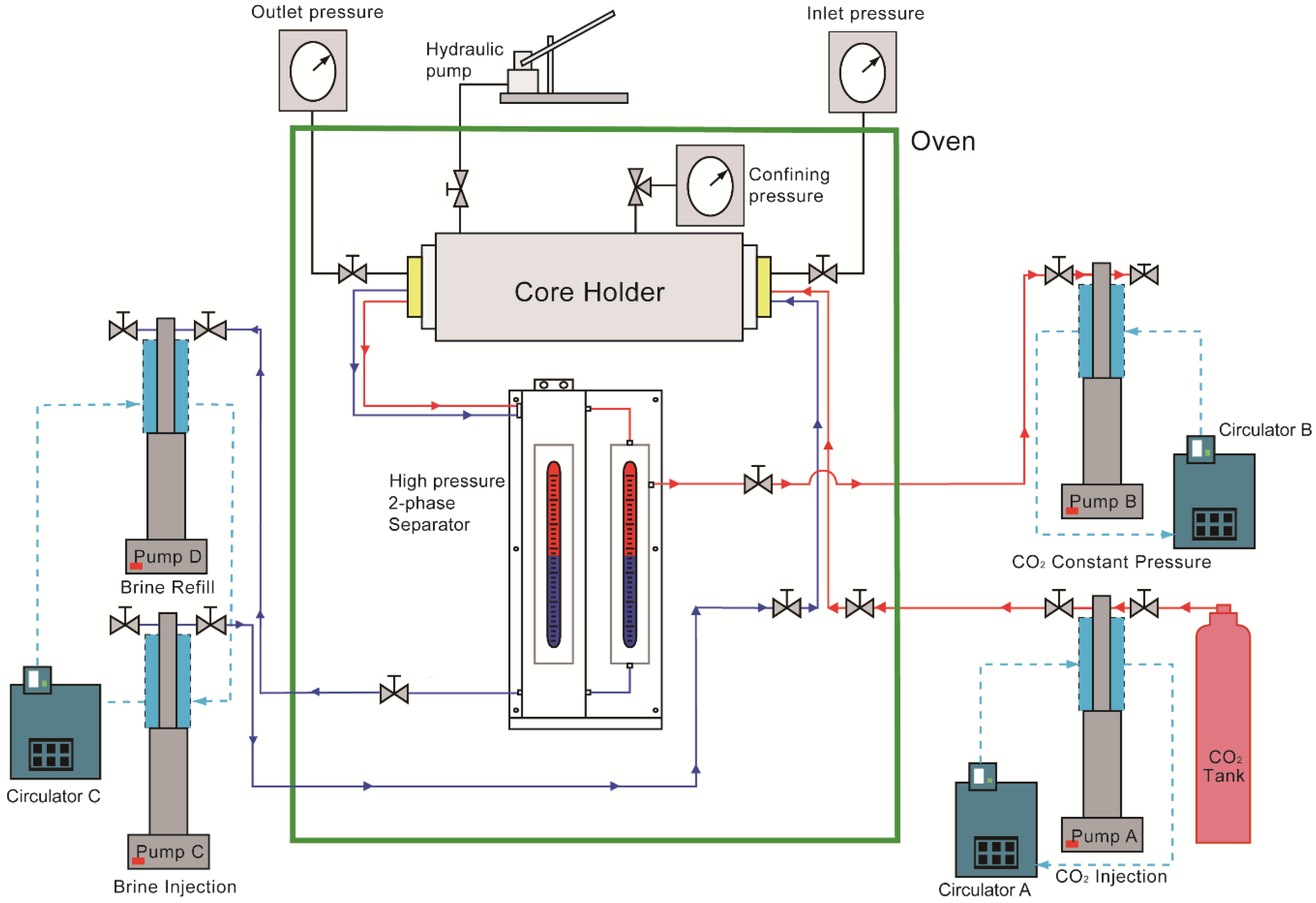
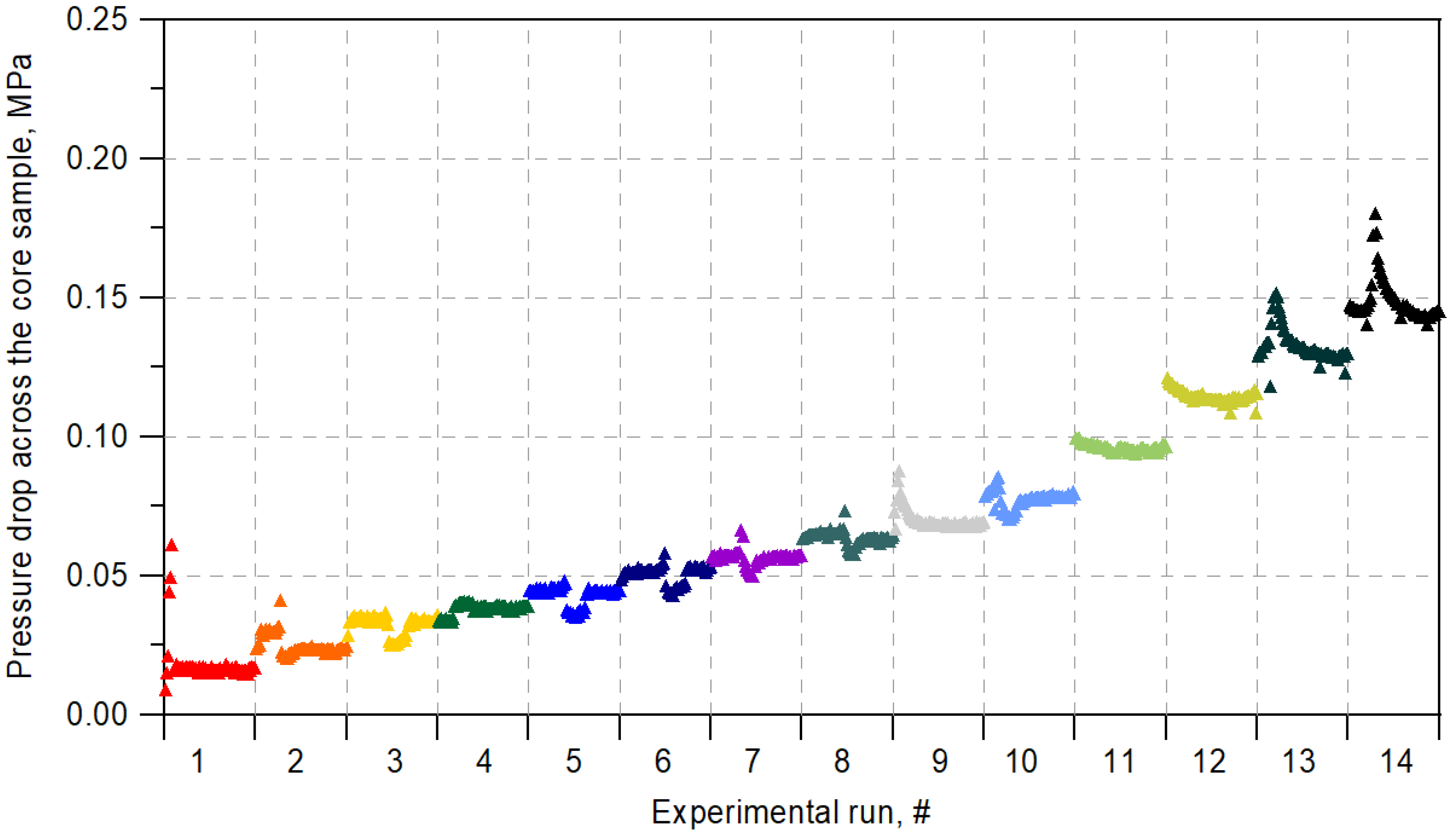
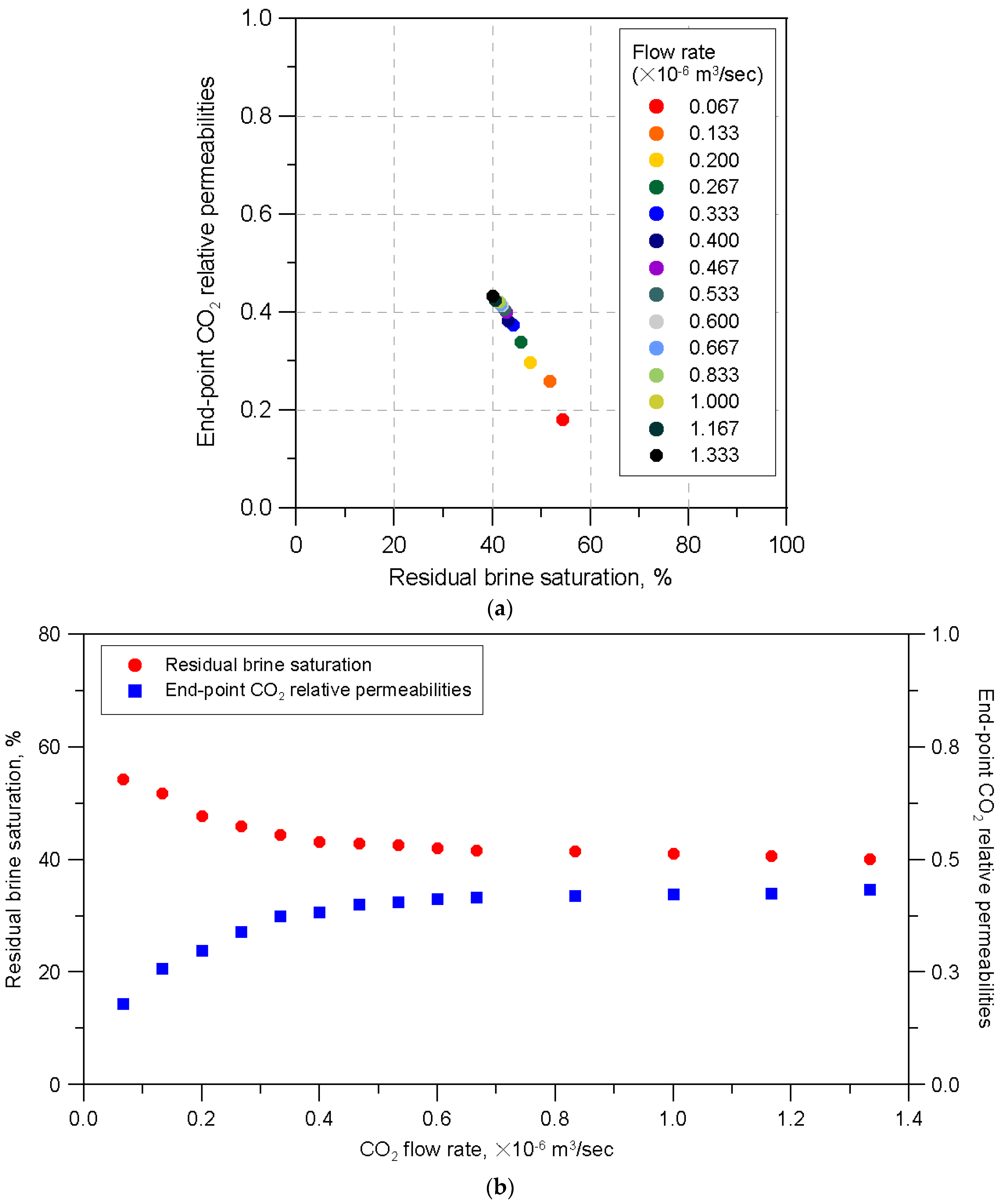


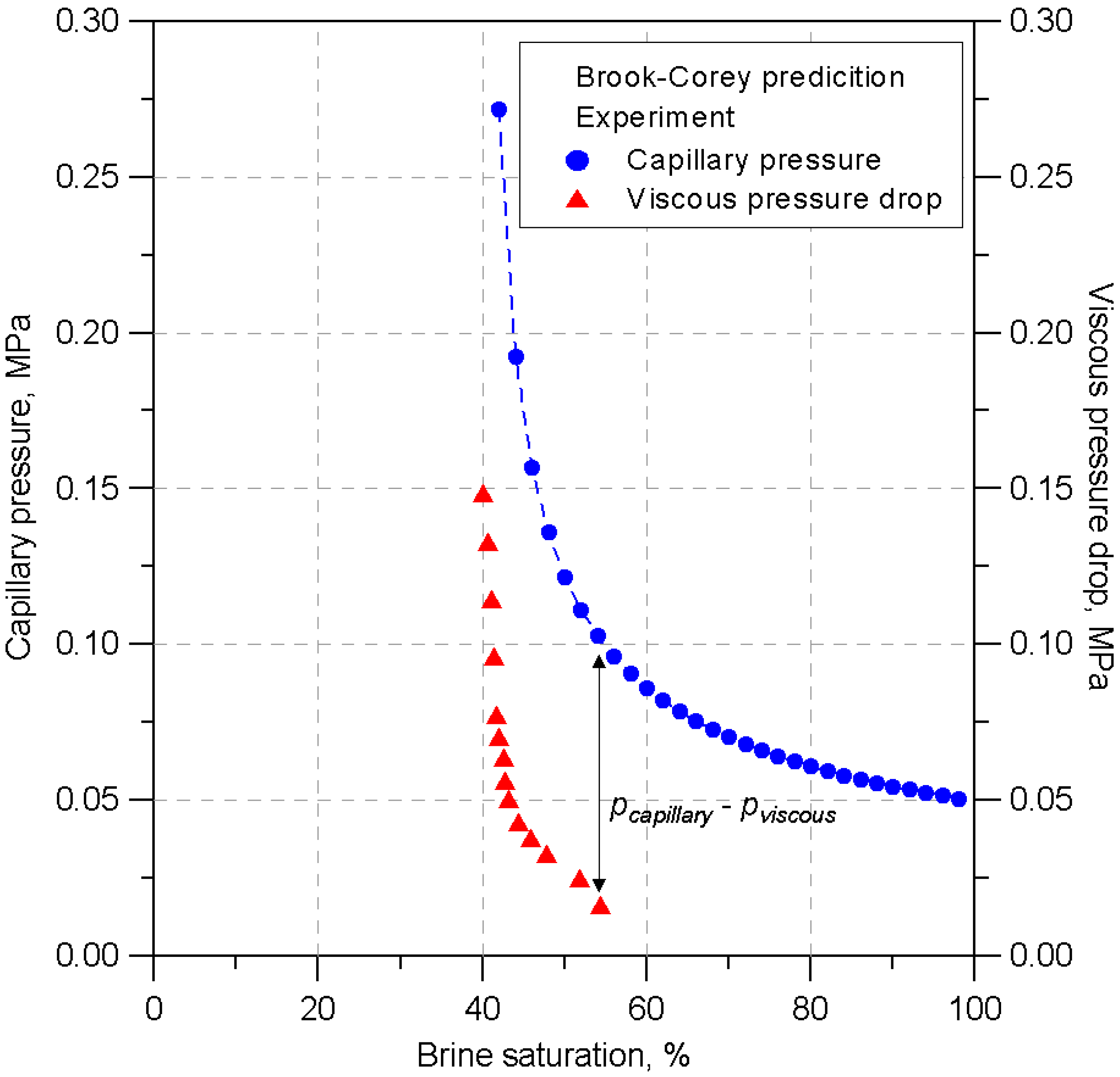

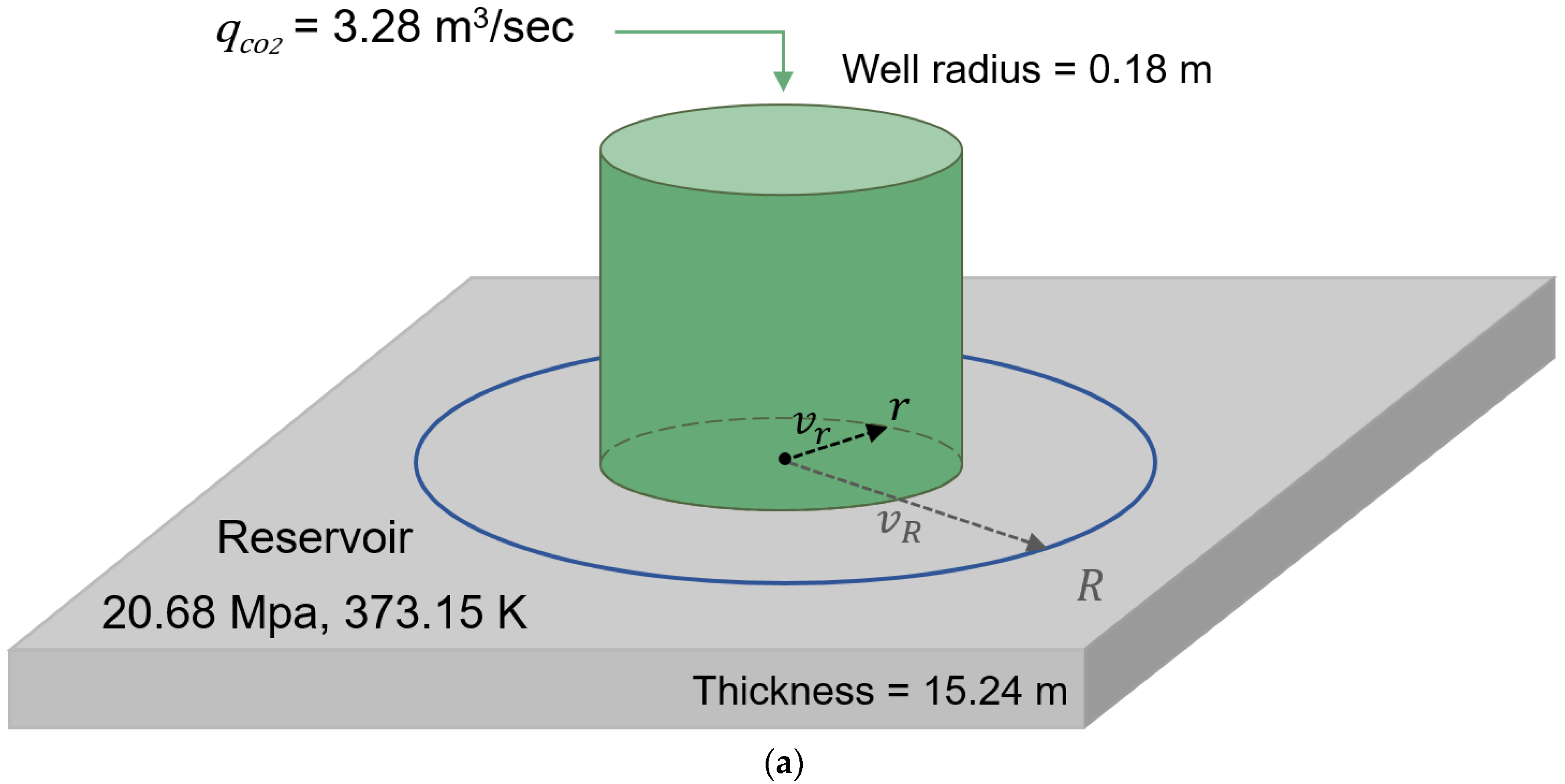
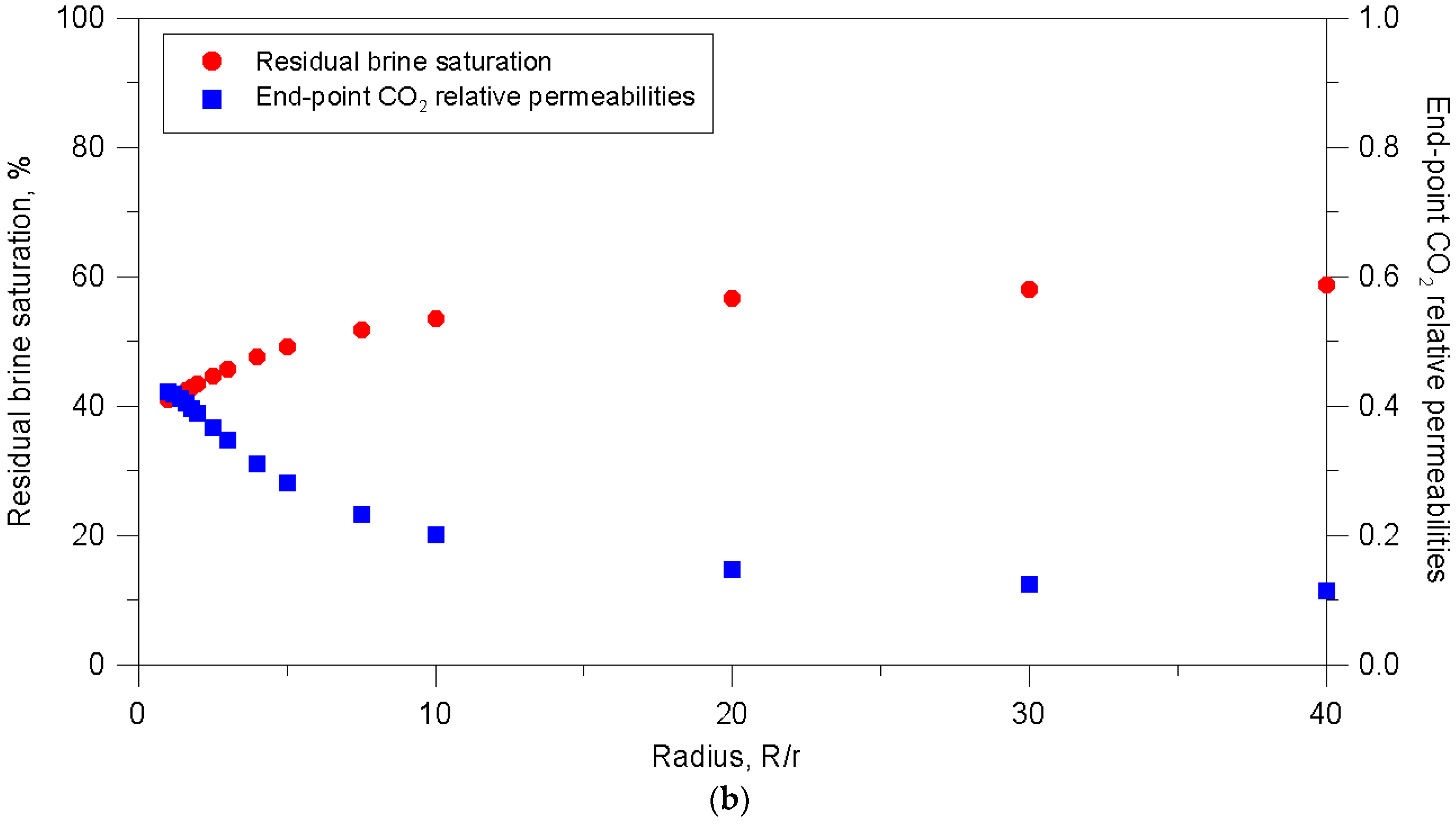
| Reference | Sample Name | Endpoint Relative Permeability (krCO2) | Residual Brine Saturation (Swirr) |
|---|---|---|---|
| Krevor et al., 2012 [9] | Berea sandstone | 0.3948 | 0.4438 |
| Paaratte | 0.3284 | 0.3894 | |
| Mt. Simon | 0.4929 | 0.4371 | |
| Tuscaloosa | 0.0767 | 0.7030 | |
| Perrin and Benson, 2010 [10] | Otway sandstone | 0.6594 | 0.4370 |
| Berea sandstone | 0.0700 | 0.5890 | |
| Bennion and Bachu, 2008 [11] | Cardium #1 | 0.5260 | 0.1970 |
| Cardium #2 | 0.1290 | 0.4250 | |
| Viking #1 | 0.3319 | 0.5580 | |
| Viking #2 | 0.2638 | 0.4230 | |
| Ellerslie #1 | 0.1156 | 0.6590 | |
| Basal Cambrian #1 | 0.5446 | 0.2940 | |
| Bachu, 2013 [12] | Ellerslie #2 | 0.5735 | 0.3820 |
| Viking #3 | 0.0973 | 0.6010 | |
| Basal Cambrian #2 | 0.2105 | 0.5690 | |
| Basal Cambrian #3 | 0.1562 | 0.4900 | |
| Basal Cambrian #4 | 0.2100 | 0.6510 | |
| Basal Cambrian #5 | 0.3255 | 0.2750 | |
| Clearwater | 0.4939 | 0.3430 | |
| Rock Creek | 0.0434 | 0.4790 | |
| Halfway | 0.2733 | 0.4660 | |
| Belloy | 0.0762 | 0.6530 | |
| Graminia | 0.1461 | 0.4420 | |
| Gilwood | 0.5454 | 0.5655 | |
| Deadwood #1 | 0.1062 | 0.4897 | |
| Deadwood #2 | 0.0941 | 0.5959 | |
| Deadwood #3 | 0.2597 | 0.6540 | |
| Granite Wash | 0.4050 | 0.5789 | |
| Shi et al., 2011 [13] | Tako Sandstone | 0.1350 | 0.5700 |
| Mean | 0.2788 | 0.4952 | |
| Standard Deviation | 0.1846 | 0.1268 |
| Rock | Fluids | ||||
|---|---|---|---|---|---|
| Sample | Porosity | Permeability | CO2 Viscosity | Brine Viscosity | Interfacial Tension |
| Berea sandstone | 18.6% ± 0.4% | 7.105 ± 0.197 × 10−14 m2 | 0.000021 Pa·s | 0.00058 Pa·s | 36.9 mN/m |
| Experimental Run | 1 | 2 | 3 | 4 | 5 | 6 | 7 | 8 | 9 | 10 | 11 | 12 | 13 | 14 |
|---|---|---|---|---|---|---|---|---|---|---|---|---|---|---|
| Flow rate (×10−6 m3/s) | 0.067 | 0.133 | 0.200 | 0.267 | 0.333 | 0.400 | 0.467 | 0.533 | 0.600 | 0.667 | 0.833 | 1.000 | 1.167 | 1.333 |
Publisher’s Note: MDPI stays neutral with regard to jurisdictional claims in published maps and institutional affiliations. |
© 2021 by the authors. Licensee MDPI, Basel, Switzerland. This article is an open access article distributed under the terms and conditions of the Creative Commons Attribution (CC BY) license (http://creativecommons.org/licenses/by/4.0/).
Share and Cite
Jeong, G.S.; Ki, S.; Lee, D.S.; Jang, I. Effect of the Flow Rate on the Relative Permeability Curve in the CO2 and Brine System for CO2 Sequestration. Sustainability 2021, 13, 1543. https://doi.org/10.3390/su13031543
Jeong GS, Ki S, Lee DS, Jang I. Effect of the Flow Rate on the Relative Permeability Curve in the CO2 and Brine System for CO2 Sequestration. Sustainability. 2021; 13(3):1543. https://doi.org/10.3390/su13031543
Chicago/Turabian StyleJeong, Gu Sun, Seil Ki, Dae Sung Lee, and Ilsik Jang. 2021. "Effect of the Flow Rate on the Relative Permeability Curve in the CO2 and Brine System for CO2 Sequestration" Sustainability 13, no. 3: 1543. https://doi.org/10.3390/su13031543
APA StyleJeong, G. S., Ki, S., Lee, D. S., & Jang, I. (2021). Effect of the Flow Rate on the Relative Permeability Curve in the CO2 and Brine System for CO2 Sequestration. Sustainability, 13(3), 1543. https://doi.org/10.3390/su13031543





